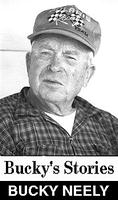|
The Sublette County Journal Volume 4, Number 23 - 2/3/00 brought to you online by Pinedale Online
Our good white-bellied mountain coyotes were in great demand, top pelts bringing around $150.00 by the fur market. They were using the belly's to dye spots on, to look like bobcat fur, which was a hotter item yet, a good light colored one with a lot of spots bringing up to $450.00. After catching the red fox breeding stock, and learning a few tricks, we decided to try it on coyotes. A crazy idea, but being a little crazy myself, I thought it might work. It had to be a heavier duty plan. We tried a few pups at first to get the hang of it, then got gutty enough to try the first full grown ones to have some mature breeding stock and some good trading material. The grown coyotes were a lot tougher than the fox, and we needed to chase the females at least 8 miles and the bigger males at least 10-12 miles before you grabbed it, if you wanted to get loose. We could do this by keeping them out in the big open and circling them around and around until they were tired enough to give up. We would never run over them, as this would be comparable to running over a cow with a D4 cat and wonder why she didn't have a calf. They had a bad habit of grabbing ahold of you and hanging on like they had lockjaw, and were big enough to mean it. I built several muzzles a little bigger than the fox ones, and they worked real good once you got it on the coyote. The big problem was how to get it on him. What worked really good was a soft, flat string like a shoestring that the vets used to tie off umbilical cords. It was real soft, and a half granny knot when jerked real tight would stay put until you could get a few more wraps and knots in it. We had already tried a big dipnet and a coyote could destruct one in a few minutes. After running a coyote far enough that he was played out, all you have to worry about are his teeth. With a half knot, the opening about four inches in diameter and your teeth holding one end, all you need is one hand to pull the other end. With the snow machine stopped and the coyote laying right alongside, you could grab him by the fur right behind his head and hold on for dear life while you positioned the noose over his nose and pull it down real tight. The real goosey part was having your head close to his and a third hand would have come in real handy. After the first loop was pulled down, this gave you the use of both hands and could quickly put on another loop and tie it, then a loop around his neck, right behind his ears would hold it on good. It was easy then to tie his feet up and he would be ready to slip the muzzle on and remove the string, then ready for the ride home. I always hired me another person to help me, and would issue him a few loops of pre-tied string. They were all gung-ho to chase the coyote, but always waited for me to get there to do the string part. I always figured I had hired too smart of help. Most of coyotes weren't loaded with fleas, and this was a help. The smaller, darker coyotes south of Pinedale were loaded with fleas, but the bigger type in the mountains were not and I could never figure this out as there has to be some intermingling during the breeding season. When we first started hauling them home, we did not tie the feet together and would put the coyote on the snow machine seat in front of you with his front legs on one side and his back legs on the other side, and one hand on top to steady him. Gary and I each had a muzzled coyote loaded this way, and stopped on top of a high hill to look the country over to try to locate another one. We couldn't see the country directly under us, and got off our machines and walked a short distance to see over the top of the hill. We were gone only a few minutes and turned around and headed back to the sleds. Out two coyotes weren't on the snow machines anymore, probably tired of the game, and had taken off. We gave each other a kind of dumbfounded look, then spotted them a few hundred yards away, getting away from us. They were pretty easy to catch the second time, as they were still pretty tired from the first long run. They still had their muzzles on and we didn't have any teeth to worry about when we caught them again. We did start hobbling their feet from there on. To Be Continued Bucky's Stories are sponsored by Walker's Agri-Service in Pinedale See The Archives for past articles. Copyright © 1999 The Sublette County Journal All rights reserved. Reproduction by any means must have permission of the Publisher. The Sublette County Journal, PO Box 3010, Pinedale, WY 82941 Phone 307-367-3713 Publisher/Editor: Rob Shaul editor@scjonline.com |
